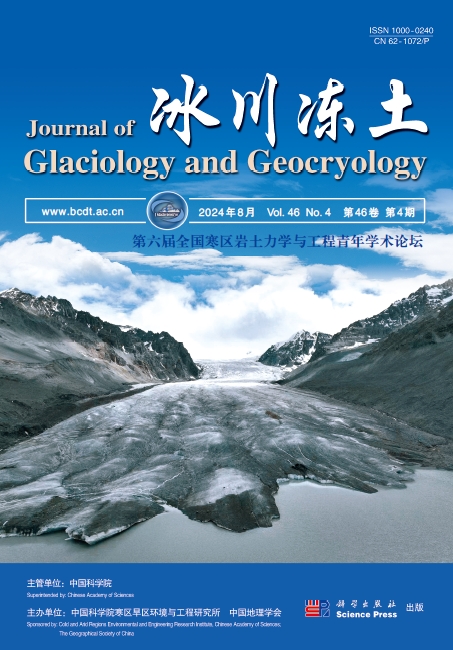Study on the Fractionation Mechanism of Stable Isotope in Evaporating Water Body
引用次数: 14
Abstract
The interaction between evaporating water body and atmosphere and the influence of different factors on evaporation are analyzed by probing into the fractionation mechanism of stable isotope as water body is vaporized under kinetic non-equilibrium and by comparison of the kinetic fractionation model with the Rayleigh equilibrium model.;A simple description of stable isotopic fractionation in the process of evaporation is Rayleigh Model. Under Rayleigh equilibrium, the following results are obtained: a) stable isotopic ratio in residual water increases with the decrease of the residual water proportion %f% exponentially; b) the fractionation rate of stable isotopes is inversely proportional to temperature; c) the simulated Rayleigh distillation line changes with temperature. The higher the temperature, the less the slope and the constant of the distillation line. The simulated distillation line is near global Meteoric Water Line as the temperature is about 20 ℃.;Besides temperature, the relative humidity %h% and the stable isotopic ratio in atmosphere %δ% a also influence the variation of stable isotopic ratio in residual water in the process of kinetic evaporation. The simulations show that, the less the %h%, the quicker the variation rate, with %f%, of stable isotopic ratio in residual water. For great %h%, the ratio δ in residual water will not change with %f% after the evaporation running for a long time, namely isotopic composition in residual water reaches a stable state. The rate of isotope reaching stable state is dependent on the relative humidity in atmosphere mainly.;Compared with the simulated results by Rayleigh Model, the enrichment degree of stable isotopes in residual water is distinctly higher, and the fractionation rate of stable isotopes is directly proportional to temperature under kinetic evaporation, as taking the relative humidity equals to 50%. The higher the temperature, the quicker the fractionation rate, which is exactly reverse to the result simulated by Rayleigh Model. Using the kinetic model, the calculated variation rates, with %f%, of the {δ 18O} in residual water are {-28.27} for %T%=30℃, {-30.40} for% T%=20 ℃and {-32.70} for %T%=10 ℃, respectively, as taking %h%=40%. These values are comparative with the evaporation experiments carried out in Nagqu of the middle Tibetan Plateau.;Under the non-equilibrium condition, the gradient and constant values of the simulated distillation line are directly proportional to temperature and relative humidity. An observation in the Qinghai Lake demonstrates that the initial stable isotopic ratios δD={-60.6}‰and δ 18O={-10.86}‰ in the water of the Qinghai Lake, the annual mean temperature %T%=0^65 ℃ and the relative humidity %h%=55%. Inputting above data into the kinetic fractionation model and taking %β%=1^006, a good agreements between the simulated distillation line (δD=5^56 δ 18O{-1.51}) and the observed line(δD=5^55δ 18O{-0.30}) was obtained.蒸发水体中稳定同位素分馏机理研究
通过对蒸发水体在动力学非平衡状态下汽化过程中稳定同位素分馏机理的探讨,以及与瑞利平衡模型的比较,分析了蒸发水体与大气的相互作用以及不同因素对蒸发的影响。在瑞利平衡下,得到以下结果:a)残余水稳定同位素比随着残余水比例%f%的减小呈指数增长;B)稳定同位素分馏速率与温度成反比;c)模拟瑞利蒸馏线随温度的变化。温度越高,精馏线的斜率和常数越小。温度约为20℃时,模拟蒸馏线接近全球大气水线,除温度外,相对湿度%h%和大气稳定同位素%δ% a也影响动力学蒸发过程中残余水稳定同位素比值的变化。模拟结果表明,%h%越小,残余水中稳定同位素比随%f%的变化率越快。当%h%较大时,蒸发运行较长时间后,剩余水的δ比值不随%f%变化,即剩余水的同位素组成达到稳定状态。与Rayleigh模型的模拟结果相比,当相对湿度为50%时,残余水中稳定同位素的富集程度明显较高,在动力蒸发条件下,稳定同位素的分馏率与温度成正比。温度越高,分馏速度越快,这与瑞利模型模拟的结果正好相反。采用动力学模型,取%h%=40%时,计算得到残余水中{δ 18O}在%T%=30℃时的变化率为{-28.27},在%T%= 20℃时的变化率为{-30.40},在%T%=10℃时的变化率为{-32.70}。在非平衡条件下,模拟蒸馏线的梯度和常数值与温度和相对湿度成正比。青海湖实测表明,青海湖水体初始稳定同位素比值δ d ={-60.6}‰,δ 18O={-10.86}‰,年平均气温%T%=0^65℃,相对湿度%h%=55%。将上述数据输入动力学分馏模型,取%β%=1^006,模拟精馏线(δ d =5^56 δ 18O{-1.51})与实测线(δ d =5^55δ 18O{-0.30})吻合较好。
本文章由计算机程序翻译,如有差异,请以英文原文为准。
求助全文
约1分钟内获得全文
求助全文
来源期刊
CiteScore
2.00
自引率
0.00%
发文量
5142
期刊介绍:
Journal of Glaciology and Geocryology (bimonthly) is an academic journal under the supervision of the Chinese Academy of Sciences (CAS), and co-sponsored by the Institute of Cold and Arid Environments and Engineering of CAS and the Chinese Geographical Society. Since its inception in 1979, the journal has focused on the study of ice, snow, permafrost and cryosphere, aiming to promote basic and applied research in related fields, facilitate academic exchanges at home and abroad, and serve the construction of national economy in cold regions. The content of the journal covers a wide range of disciplines, including glaciology, permafrost, hydrology, geo-ecology, etc., focusing on resources, environment, engineering and global change in the cryosphere. The readers are professionals in the fields of glaciology, permafrost, and hydrology, ecology and global change in the cold zone, teachers and students in colleges and universities, and leaders and cadres of governmental management departments.
Journal of Glaciology and Geocryology has a wide influence in China, and is included in many famous databases and retrieval systems at home and abroad, including Peking University's ‘Chinese Core Journals List’, China Science and Technology Core Journals (CSTPCD), and Source Journals of China Science Citation Database (CSCD), etc., and has been in several journals grading catalogues The journal has been distributed to more than 20 countries. The journal has been distributed to more than 20 countries and regions, and has been indexed by international retrieval systems such as Scopus, which has a good internationalisation prospect.

 求助内容:
求助内容: 应助结果提醒方式:
应助结果提醒方式:


